sensor Acura MDX 2015 Owner's Guide
[x] Cancel search | Manufacturer: ACURA, Model Year: 2015, Model line: MDX, Model: Acura MDX 2015Pages: 79, PDF Size: 16.44 MB
Page 4 of 79
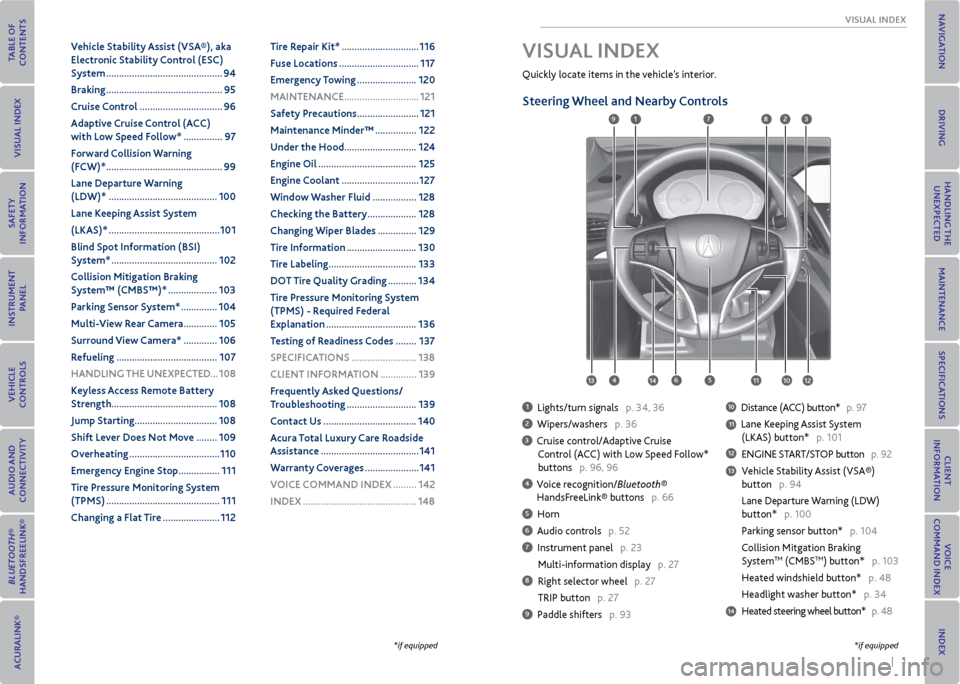
| 1
vISUAL INDex
Quickly locate items in the vehicle’s interior.
Steering Wheel and Nearby Controls
1 Lights/turn signals p. 34, 36
2 Wipers/washers p. 36
3 Cruise control/Adaptive Cruise
Control (ACC) with Low Speed Follow*
buttons p. 96, 96
4 Voice recognition/Bluetooth®
HandsFreeLink® buttons p. 66
5 Horn
6 Audio controls p. 52
7 Instrument panel p. 23
Multi-information display p. 27
8 Right selector wheel p. 27
TRIP button p. 27
9 Paddle shifters p. 93
10 Distance (ACC) button* p. 97
11 Lane Keeping Assist System
(LKAS) button* p. 101
12 ENGINE START/STOP button p. 92
13 Vehicle Stability Assist (VSA®)
button p. 94
Lane Departure Warning (LDW)
button* p. 100
Parking sensor button* p. 104
Collision Mitgation Braking
System
TM (CMBSTM) button* p. 103
Heated windshield button* p. 48
Headlight washer button* p. 34
14 Heated steering wheel button* p. 48
vISUAL INDex
1
45
9
61011
7283
131412
*if equipped*if equipped
v ehicle Stability Assist (vSA®), aka
electronic Stability Control (eSC)
System ............................................. 94
Braking ............................................. 95
Cruise Control ................................ 96
Adaptive Cruise Control (ACC)
with Low Speed Follow* ............... 97
Forward Collision Warning
(FCW)* ............................................. 99
Lane Departure Warning
(LDW)* .......................................... 100
Lane Keeping Assist System
(LKAS)* ........................................... 101
Blind Spot Information (BSI)
System* ......................................... 102
Collision mitigation Braking
System™ (CmBS™)* ................... 103
Parking Sensor System* .............. 104
multi- view rear Camera ............. 105
Surround view Camera* ............. 106
r efueling ....................................... 107
HANDLING THe UNexPeCTeD ...108
Keyless Access r emote Battery
Strength ......................................... 108
Jump Starting ................................ 108
Shift Lever Does Not move ........ 109
overheating ................................... 110
emergency engine Stop ................ 111
Tire Pressure monitoring System
(TPmS) ............................................ 111
Changing a Flat Tire ...................... 112Tire r
epair Kit* .............................. 116
Fuse Locations ............................... 117
emergency Towing ....................... 120
mAINTeNANCe ............................. 121
Safety Precautions ........................ 121
maintenance minder™ ................ 122
Under the Hood ............................ 124
engine oil ...................................... 125
engine Coolant .............................. 127
Window Washer Fluid ................. 128
Checking the Battery ................... 128
Changing Wiper Blades ............... 129
Tire Information ........................... 130
Tire Labeling .................................. 133
Do T Tire Quality Grading ........... 134
Tire Pressure monitoring System
(TPmS) - r equired Federal
explanation ................................... 136
Testing of readiness Codes ........ 137
SPeCIFICATIoNS ......................... 138
CLIeNT INFormATIoN .............. 139
Frequently Asked Questions/
Troubleshooting ........................... 139
Contact Us .................................... 140
Acura Total Luxury Care r oadside
Assistance ...................................... 141
Warranty Coverages ..................... 141
v oICe CommAND INDex ......... 142
INDex ............................................ 148
Page 8 of 79
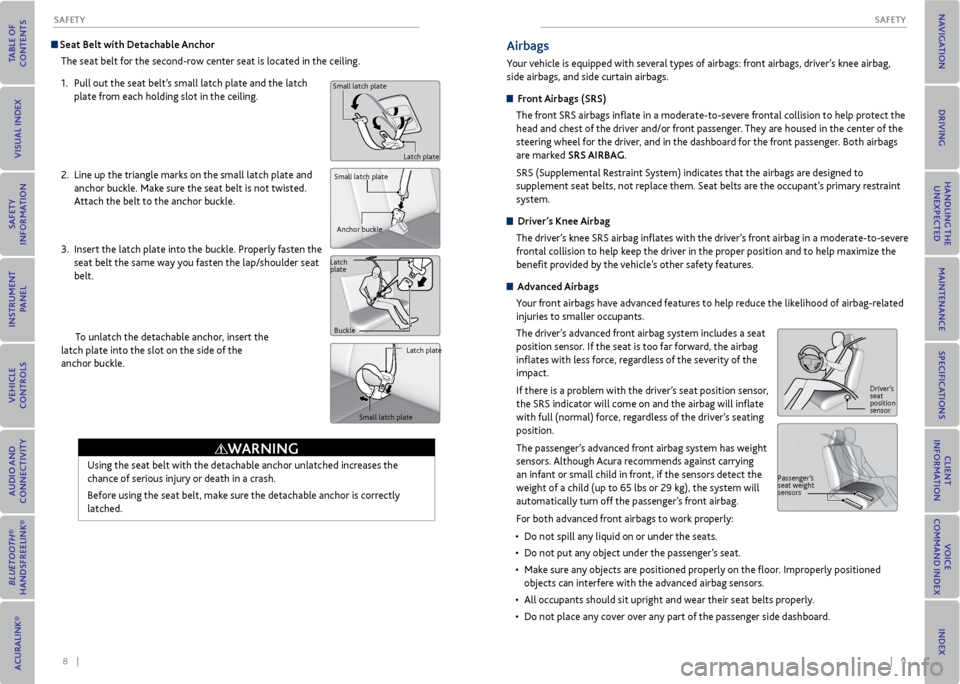
8 || 9
SAFeTy
SAFeTy
Seat Belt with Detachable Anchor
The seat belt for the second-row center seat is located in the ceiling.
1. Pull out the seat belt’s small latch plate and the latch
plate from each holding slot in the ceiling.
2. Line up the triangle marks on the small latch plate and
anchor buckle. Make sure the seat belt is not twisted.
Attach the belt to the anchor buckle.
3. Insert the latch plate into the buckle. Properly fasten the
seat belt the same way you fasten the lap/shoulder seat
belt.
To unlatch the detachable anchor, insert the
latch plate into the slot on the side of the
anchor buckle.
Using the seat belt with the detachable anchor unlatched increases the
chance of serious injury or death in a crash.
Before using the seat belt, make sure the detachable anchor is correctly
latched.
Small latch plate Latch plate
Small latch plate
Anchor buckle
Latch
plate
Buckle Latch plate
Small latch plate
WArNING
Airbags
Your vehicle is equipped with several types of airbags: front airbags, driver’s knee airbag,
side airbags, and side curtain airbags.
Front Airbags (SrS) The front SRS airbags inflate in a moderate-to-severe frontal collision to help protect the
head and chest of the driver and/or front passenger. They are housed in the center of the
steering wheel for the driver, and in the dashboard for the front passenger. Both airbags
are marked SrS AIrBAG.
SRS (Supplemental Restraint System) indicates that the airbags are designed to
supplement seat belts, not replace them. Seat belts are the occupant’s primary restraint
system.
Driver’s Knee Airbag The driver’s knee SRS airbag inflates with the driver’s front airbag in a moderate-to-severe
frontal collision to help keep the driver in the proper position and to help maximize the
benefit provided by the vehicle’s other safety features.
Advanced Airbags
Your front airbags have advanced features to help reduce the likelihood of airbag-related
injuries to smaller occupants.
The driver’s advanced front airbag system includes a seat
position sensor. If the seat is too far forward, the airbag
inflates with less force, regardless of the severity of the
impact.
If there is a problem with the driver’s seat position sensor,
the SRS indicator will come on and the airbag will inflate
with full (normal) force, regardless of the driver’s seating
position.
The passenger’s advanced front airbag system has weight
sensors. Although Acura recommends against carrying
an infant or small child in front, if the sensors detect the
weight of a child (up to 65 lbs or 29 kg), the system will
automatically turn off the passenger’s front airbag.
For both advanced front airbags to work properly:
• Do not spill any liquid on or under the seats.
• Do not put any object under the passenger’s seat.
• Make sure any objects are positioned properly on the floor. Improperly positioned
objects can interfere with the advanced airbag sensors.
• All occupants should sit upright and wear their seat belts properly.
• Do not place any cover over any part of the passenger side dashboard.
Driver’s
seat
position
sensor
Passenger’s
seat weight
sensors
Page 10 of 79
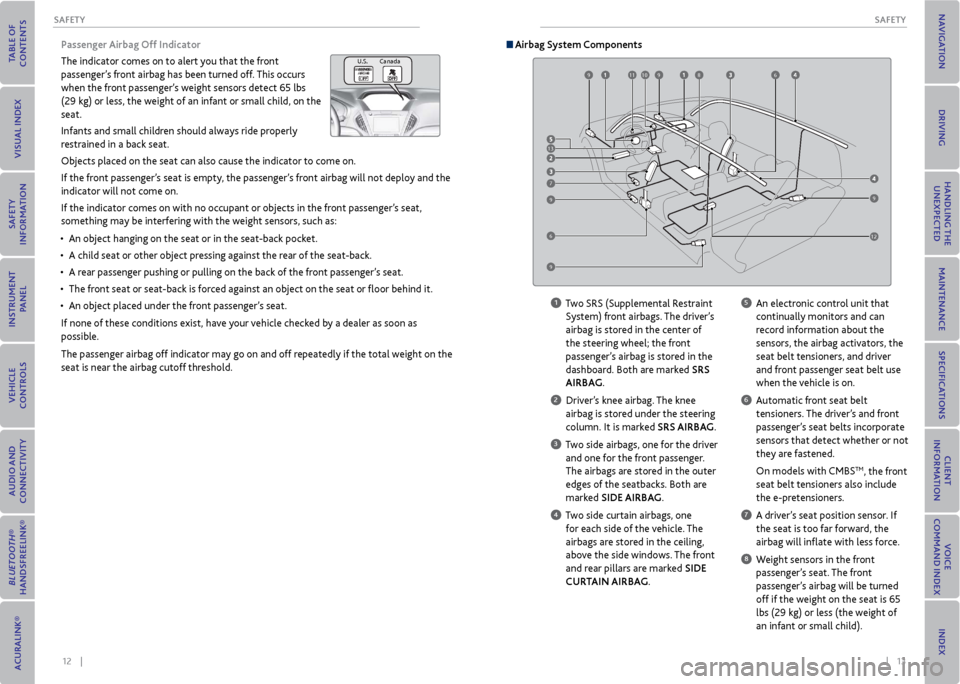
12 || 13
SAFeTy
SAFeTy
Passenger Airbag off Indicator
The indicator comes on to alert you that the front
passenger’s front airbag has been turned off. This occurs
when the front passenger’s weight sensors detect 65 lbs
(29 kg) or less, the weight of an infant or small child, on the
seat.
Infants and small children should always ride properly
restrained in a back seat.
Objects placed on the seat can also cause the indicator to come on.
If the front passenger’s seat is empty, the passenger’s front airbag will not deploy and the
indicator will not come on.
If the indicator comes on with no occupant or objects in the front passenger’s seat,
something may be interfering with the weight sensors, such as:
• An object hanging on the seat or in the seat-back pocket.
• A child seat or other object pressing against the rear of the seat-back.
• A rear passenger pushing or pulling on the back of the front passenger’s seat.
• The front seat or seat-back is forced against an object on the seat or floor behind it.
• An object placed under the front passenger’s seat.
If none of these conditions exist, have your vehicle checked by a dealer as soon as
possible.
The passenger airbag off indicator may go on and off repeatedly if the total weight on the
seat is near the airbag cutoff threshold.
U.S. Canada
Airbag System Components
13
6
7
810119
99
9
612
9
1 Two SRS (Supplemental Restraint
System) front airbags. The driver’s
airbag is stored in the center of
the steering wheel; the front
passenger’s airbag is stored in the
dashboard. Both are marked SrS
AIrBAG.
2 Driver’s knee airbag. The knee airbag is stored under the steering
column. It is marked SrS AIrBAG.
3 Two side airbags, one for the driver and one for the front passenger.
The airbags are stored in the outer
edges of the seatbacks. Both are
marked SIDe AIrBAG.
4 Two side curtain airbags, one for each side of the vehicle. The
airbags are stored in the ceiling,
above the side windows. The front
and rear pillars are marked SIDe
CUr TAIN AIrBAG.
5 An electronic control unit that
continually monitors and can
record information about the
sensors, the airbag activators, the
seat belt tensioners, and driver
and front passenger seat belt use
when the vehicle is on.
6 Automatic front seat belt tensioners. The driver’s and front
passenger’s seat belts incorporate
sensors that detect whether or not
they are fastened.
On models with CMBS
TM, the front
seat belt tensioners also include
the e-pretensioners.
7 A driver’s seat position sensor. If the seat is too far forward, the
airbag will inflate with less force.
8 Weight sensors in the front passenger’s seat. The front
passenger’s airbag will be turned
off if the weight on the seat is 65
lbs (29 kg) or less (the weight of
an infant or small child).
Page 11 of 79
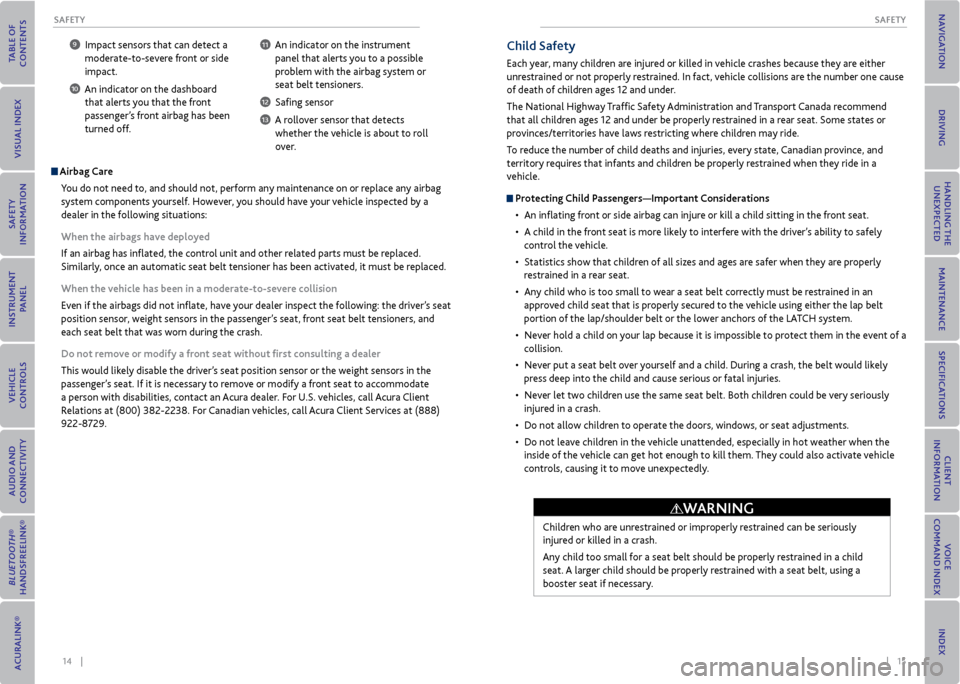
14 || 15
SAFeTy
SAFeTy
9 Impact sensors that can detect a
moderate-to-severe front or side
impact.
10 An indicator on the dashboard that alerts you that the front
passenger’s front airbag has been
turned off.
11 An indicator on the instrument panel that alerts you to a possible
problem with the airbag system or
seat belt tensioners.
12 Safing sensor
13 A rollover sensor that detects whether the vehicle is about to roll
over.
Airbag Care
You do not need to, and should not, perform any maintenance on or replace any airbag
system components yourself. However, you should have your vehicle inspected by a
dealer in the following situations:
When the airbags have deployed
If an airbag has inflated, the control unit and other related parts must be replaced.
Similarly, once an automatic seat belt tensioner has been activated, it must be replaced.
When the vehicle has been in a moderate-to-severe collision
Even if the airbags did not inflate, have your dealer inspect the following: the driver’s seat
position sensor, weight sensors in the passenger’s seat, front seat belt tensioners, and
each seat belt that was worn during the crash.
Do not remove or modify a front seat without first consulting a dealer
This would likely disable the driver’s seat position sensor or the weight sensors in the
passenger’s seat. If it is necessary to remove or modify a front seat to accommodate
a person with disabilities, contact an Acura dealer. For U.S. vehicles, call Acura Client
Relations at (800) 382-2238. For Canadian vehicles, call Acura Client Services at (888)
922-8729.
Child Safety
Each year, many children are injured or killed in vehicle crashes because they are either
unrestrained or not properly restrained. In fact, vehicle collisions are the number one cause
of death of children ages 12 and under.
The National Highway Traffic Safety Administration and Transport Canada recommend
that all children ages 12 and under be properly restrained in a rear seat. Some states or
provinces/territories have laws restricting where children may ride.
To reduce the number of child deaths and injuries, every state, Canadian province, and
territory requires that infants and children be properly restrained when they ride in a
vehicle.
Protecting Child Passengers—Important Considerations • An inflating front or side airbag can injure or kill a child sitting in the front seat.
• A child in the front seat is more likely to interfere with the driver’s ability to safely
control the vehicle.
• Statistics show that children of all sizes and ages are safer when they are properly
restrained in a rear seat.
• Any child who is too small to wear a seat belt correctly must be restrained in an
approved child seat that is properly secured to the vehicle using either the lap belt
portion of the lap/shoulder belt or the lower anchors of the LATCH system.
• Never hold a child on your lap because it is impossible to protect them in the event of a
collision.
• Never put a seat belt over yourself and a child. During a crash, the belt would likely
press deep into the child and cause serious or fatal injuries.
• Never let two children use the same seat belt. Both children could be very seriously
injured in a crash.
• Do not allow children to operate the doors, windows, or seat adjustments.
• Do not leave children in the vehicle unattended, especially in hot weather when the
inside of the vehicle can get hot enough to kill them. They could also activate vehicle
controls, causing it to move unexpectedly.
Children who are unrestrained or improperly restrained can be seriously
injured or killed in a crash.
Any child too small for a seat belt should be properly restrained in a child
seat. A larger child should be properly restrained with a seat belt, using a
booster seat if necessary.
WArNING
Page 16 of 79
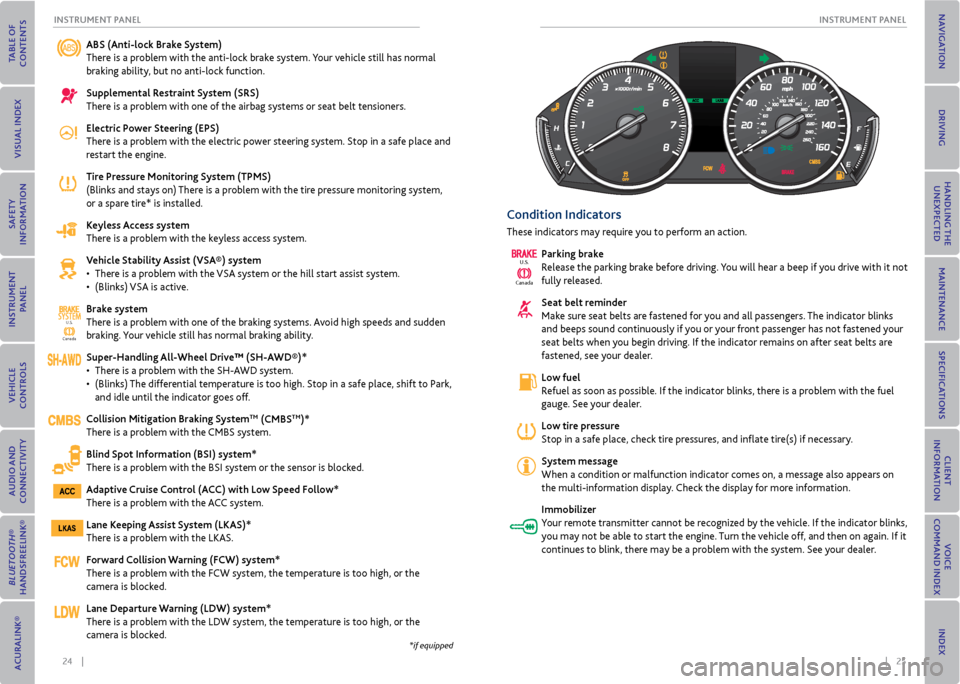
24 || 25
INSTrUmeNT P
ANeL
INSTrUmeNT P ANeL
ABS (Anti-lock Brake System)
There is a problem with the anti-lock brake system. Your vehicle still has normal
braking ability, but no anti-lock function.
Supplemental restraint System (SrS)
There is a problem with one of the airbag systems or seat belt tensioners.
electric Power Steering (ePS)
There is a problem with the electric power steering system. Stop in a safe place and
restart the engine.
Tire Pressure monitoring System (TPmS)
(Blinks and stays on) There is a problem with the tire pressure monitoring system,
or a spare tire* is installed.
Keyless Access system
There is a problem with the keyless access system.
v ehicle Stability Assist (vSA®) system
• There is a problem with the VSA system or the hill start assist system.
• (Blinks) VSA is active.
Brake system
There is a problem with one of the braking systems. Avoid high speeds and sudden
braking. Your vehicle still has normal braking ability.
Super-Handling All-Wheel Drive™ (SH-AWD®)*
• There is a problem with the SH-AWD system.
• (Blinks) The differential temperature is too high. Stop in a safe place, shift to Park,
and idle until the indicator goes off.
Collision mitigation Braking System
Tm (CmBSTm)*
There is a problem with the CMBS system.
Blind Spot Information (BSI) system*
There is a problem with the BSI system or the sensor is blocked.
Adaptive Cruise Control (ACC) with Low Speed Follow*
There is a problem with the ACC system.
Lane Keeping Assist System (LKAS)*
There is a problem with the LKAS.
Forward Collision Warning (FCW) system*
There is a problem with the FCW system, the temperature is too high, or the
camera is blocked.
Lane Departure Warning (LDW) system*
There is a problem with the LDW system, the temperature is too high, or the
camera is blocked.
Ca nada
U.S.
SYSTEM
Condition Indicators
These indicators may require you to perform an action.
Parking brake
Release the parking brake before driving. You will hear a beep if you drive with it not
fully released.
Seat belt reminder
Make sure seat belts are fastened for you and all passengers. The indicator blinks
and beeps sound continuously if you or your front passenger has not fastened your
seat belts when you begin driving. If the indicator remains on after seat belts are
fastened, see your dealer.
Low fuel
Refuel as soon as possible. If the indicator blinks, there is a problem with the fuel
gauge. See your dealer.
Low tire pressure
Stop in a safe place, check tire pressures, and inflate tire(s) if necessary.
System message
When a condition or malfunction indicator comes on, a message also appears on
the multi-information display. Check the display for more information.
Immobilizer
Your remote transmitter cannot be recognized by the vehicle. If the indicator blinks,
you may not be able to start the engine. Turn the vehicle off, and then on again. If it
continues to blink, there may be a problem with the system. See your dealer.
Canada
U.S.
*if equipped
Page 22 of 79
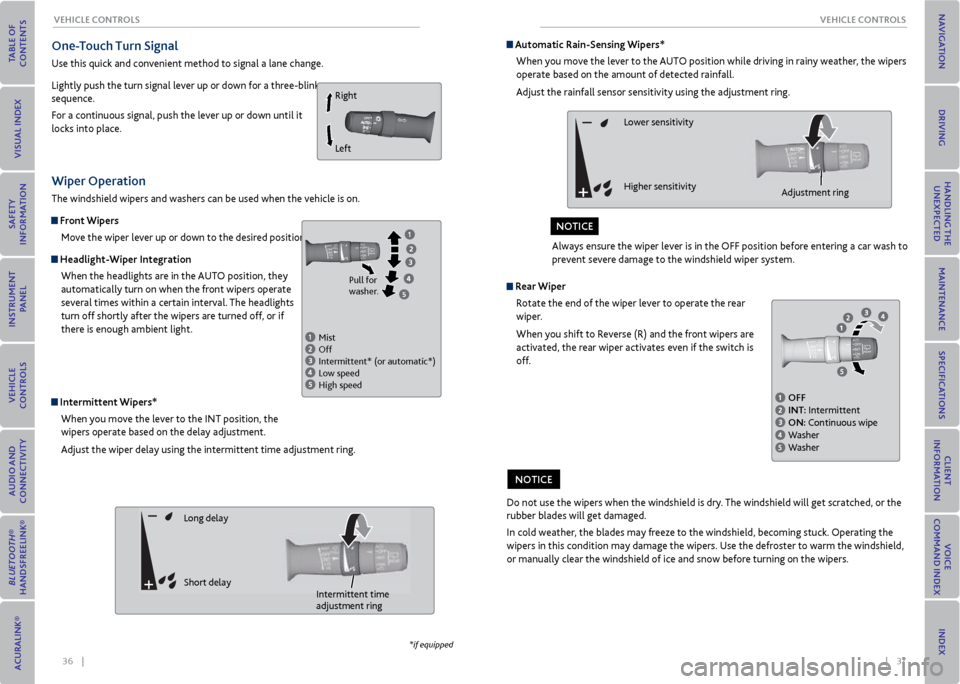
36 || 37
veHICLe CoNTroLS
veHICLe CoNTroLS
one-Touch Turn Signal
Use this quick and convenient method to signal a lane change.
Lightly push the turn signal lever up or down for a three-blink
sequence.
For a continuous signal, push the lever up or down until it
locks into place.
Wiper operation
The windshield wipers and washers can be used when the vehicle is on.
Front Wipers
Move the wiper lever up or down to the desired position.
Headlight-Wiper IntegrationWhen the headlights are in the AUTO position, they
automatically turn on when the front wipers operate
several times within a certain interval. The headlights
turn off shortly after the wipers are turned off, or if
there is enough ambient light.
Intermittent Wipers*When you move the lever to the INT position, the
wipers operate based on the delay adjustment.
Adjust the wiper delay using the intermittent time adjustment ring.
Right
Left
*if equipped
Automatic rain-Sensing Wipers*
When you move the lever to the AUTO position while driving in rainy weather, the wipers
operate based on the amount of detected rainfall.
Adjust the rainfall sensor sensitivity using the adjustment ring.
r ear Wiper
Rotate the end of the wiper lever to operate the rear
wiper.
When you shift to Reverse (R) and the front wipers are
activated, the rear wiper activates even if the switch is
off.
Mist
Off
Intermittent* (or automatic*)
Low speed
High speed Pull for
washer.
Long delay
Short delay
Lower sensitivity
Higher sensitivity
Intermittent time
adjustment ring
Adjustment ring
Do not use the wipers when the windshield is dry. The windshield will get scratched, or the
rubber blades will get damaged.
In cold weather, the blades may freeze to the windshield, becoming stuck. Operating the
wipers in this condition may damage the wipers. Use the defroster to warm the windshield,
or manually clear the windshield of ice and snow before turning on the wipers.
No TICe
oFF
INT: Intermittent
oN: Continuous wipe
Washer
Washer
Always ensure the wiper lever is in the OFF position before entering a car wash to
prevent severe damage to the windshield wiper system.
NoTICe
Page 24 of 79
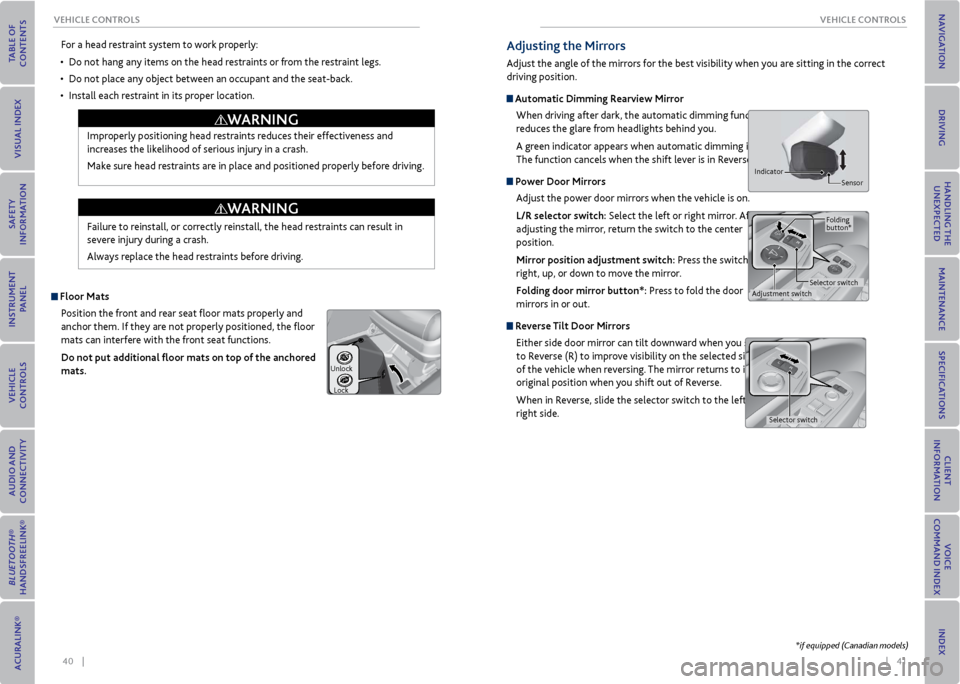
40 || 41
veHICLe CoNTroLS
veHICLe CoNTroLS
For a head restraint system to work properly:
• Do not hang any items on the head restraints or from the restraint legs.
• Do not place any object between an occupant and the seat-back.
• Install each restraint in its proper location.
Improperly positioning head restraints reduces their effectiveness and
increases the likelihood of serious injury in a crash.
Make sure head restraints are in place and positioned properly before driving.
Failure to reinstall, or correctly reinstall, the head restraints can result in
severe injury during a crash.
Always replace the head restraints before driving.
WArNING
WArNING
Floor matsPosition the front and rear seat floor mats properly and
anchor them. If they are not properly positioned, the floor
mats can interfere with the front seat functions.
Do not put additional floor mats on top of the anchored
mats.
Unlock
Lock
Adjusting the mirrors
Adjust the angle of the mirrors for the best visibility when you are sitting in the correct
driving position.
Automatic Dimming r earview mirror
When driving after dark, the automatic dimming function
reduces the glare from headlights behind you.
A green indicator appears when automatic dimming is on.
The function cancels when the shift lever is in Reverse (R).
Power Door mirrors Adjust the power door mirrors when the vehicle is on.
L/r selector switch: Select the left or right mirror. After
adjusting the mirror, return the switch to the center
position.
mirror position adjustment switch: Press the switch left,
right, up, or down to move the mirror.
Folding door mirror button*: Press to fold the door
mirrors in or out.
r everse Tilt Door mirrors
Either side door mirror can tilt downward when you shift
to Reverse (R) to improve visibility on the selected side
of the vehicle when reversing. The mirror returns to its
original position when you shift out of Reverse.
When in Reverse, slide the selector switch to the left or
right side.
Indicator Sensor
Adjustment switchSelector switchFolding
button*
Selector switch
*if equipped (Canadian models)
Page 56 of 79

104 || 105
DrIvING
DrIvING
Parking Sensor System*
When the system senses an object when you are parking or backing up, an indicator appears
on the upper display and a series of beeps will sound. As you get closer to the object, the
beep rate increases.
Turning the System on or off
Press the parking sensor button. A green indicator light
appears on the button when the system is on.
Indicators appear when the
sensor device detects an
obstacle.
*if equipped
Indicator
multi- view r ear Camera
When you shift into Reverse (R), a real-time image of the area behind your vehicle is shown
in the display, along with helpful parking guidelines.
The rear camera view is restricted. You cannot see the corner ends of the bumper or what is underneath the
bumper. Its unique lens also makes objects appear closer or farther than they actually are.
Visually confirm that it is safe to drive before backing up. Certain conditions (such as weather, lighting, and high
temperatures) may also restrict the rear view. Do not rely on the rearview display, which does not give you all
information about conditions at the rear of your vehicle.
Wide view Normal view Top down view
Press the
interface dial
to toggle
between
views.
Changing Guidelines
Turn the guidelines on or off. Use the interface dial to make and enter selections.
1. Press SETTINGS.
2. Select Camera Settings
3. Select one of the options.
Fixed Guidelines: Guidelines appear when you shift into
Reverse. Select On or Off.
Dynamic Guidelines: Guidelines move as you turn the
steering wheel. Select On or Off.
4. Press BACK to exit the menu.
Page 62 of 79
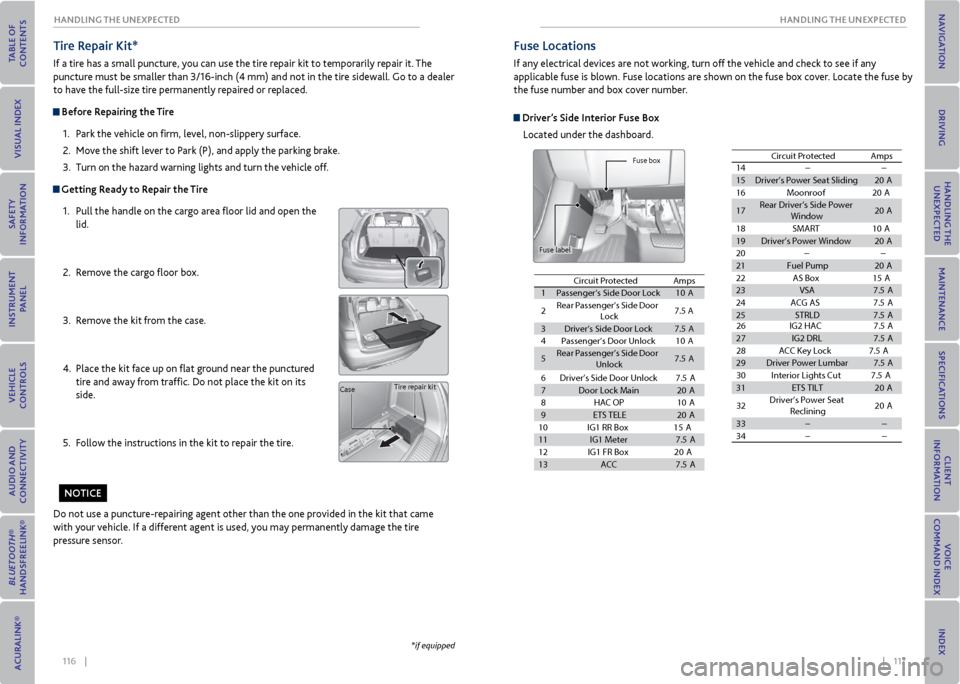
116 || 117
HANDLING THe UNexPeCTeD
HANDLING THe UNexPeCTeD
Tire r epair Kit*
If a tire has a small puncture, you can use the tire repair kit to temporarily repair it. The
puncture must be smaller than 3/16-inch (4 mm) and not in the tire sidewall. Go to a dealer
to have the full-size tire permanently repaired or replaced.
Before r epairing the Tire
1. Park the vehicle on firm, level, non-slippery surface.
2. Move the shift lever to Park (P), and apply the parking brake.
3. Turn on the hazard warning lights and turn the vehicle off.
Getting ready to repair the Tire
1. Pull the handle on the cargo area floor lid and open the
lid.
2. Remove the cargo floor box.
3. Remove the kit from the case.
4. Place the kit face up on flat ground near the punctured
tire and away from traffic. Do not place the kit on its
side.
5. Follow the instructions in the kit to repair the tire.
Do not use a puncture-repairing agent other than the one provided in the kit that came
with your vehicle. If a different agent is used, you may permanently damage the tire
pressure sensor.
Tire repair kit
Case
*if equipped
No TICe
Fuse Locations
If any electrical devices are not working, turn off the vehicle and check to see if any
applicable fuse is blown. Fuse locations are shown on the fuse box cover. Locate the fuse by
the fuse number and box cover number.
Driver’s Side Interior Fuse Box
Located under the dashboard.
Fuse box
Fuse label
Circuit ProtectedAmps
1Passenger’s Side Door Lock10 A
2Rear Passenger’s Side Door
Lock7.5 A
3Driver’s Side Door Lock7.5A
4Passenger’s Door Unloc k10A
5Rear Passenger’s Side Door Unlock7.5A
6 Driver’s Side Door Unlock 7.5A
7 Door Lock Main 20A
8 HAC OP 10A
9 ETS TELE 20A
10 IG1 RR Box1 5A
11 IG1 Meter 7.5A
12 IG1 FR Box2 0A
13 ACC 7.5A
14 ��
15 Driver’s Power Seat Sliding 20A
16 Moonroof 20A
17 Rear Driver’s Side Power
Window 20
A
18 SMART 10A
19 Driver’s Power Windo w20A
20 ��
21 Fuel Pump 20A
22 AS Box 15A
23 VSA 7.5A
24 ACG AS 7.5A
25 STRLD 7.5A
Circuit Protecte
dAmps
26 IG2 HAC 7.5A
27 IG2 DRL 7.5A
28 ACC Key Lock 7.5A
29 Driver Power Lumbar 7.5A
30 Interior Lights Cut 7.5A
31 ETS TILT 20A
32 Driver’s Power Seat
Reclining 20
A
33 � �
34 � �
Circuit Protected
Amps
Circuit Protected Amps
1 Passenger’s Side Door Lock 10A
2 Rear
Passenger’s Side Door
Lock 7.5
A
3 Driver’s Side Door Lock 7.5A
4 Passenger’s Door Unloc k10A
5 Rear
Passenger’s Side Door
Unlock 7.
5A
6Driver’s Side Door Unlock7.5A
7Door Lock Main20 A
8HAC OP10A
9ETS TELE20A
10 IG1 RR Bo
x15A
11IG1 Meter7.5A
12 IG1 FR Bo
x20A
13ACC7.5A
14 ��
15 Driver’s Power Seat Sliding 20A
16 Moonroof 20A
17 Rear Driver’s Side Power
Window 20
A
18 SMART 10A
19 Driver’s Power Windo w20A
20 ��
21 Fuel Pump 20A
22 AS Box 15A
23 VSA 7.5A
24 ACG AS 7.5A
25 STRLD 7.5A
Circuit Protecte dAmps
26IG2 HAC 7.5A
27 IG2 DRL 7.5A
28 ACC Key Lock 7.5A
29 Driver Power Lumbar 7.5A
30 Interior Lights Cut 7.5A
31 ETS TILT 20A
32 Driver’s Power Seat
Reclining 20
A
33 � �
34 � �
Circuit Protected
Amps
Circuit Protected Amps
1 Passenger’s Side Door Lock 10A
2 Rear
Passenger’s Side Door
Lock 7.5
A
3 Driver’s Side Door Lock 7.5A
4 Passenger’s Door Unloc k10A
5 Rear
Passenger’s Side Door
Unlock 7.
5A 6
Driver’s Side Door Unlock 7.5A
7 Door Lock Main 20A
8 HAC OP 10A
9 ETS TELE 20A
10 IG1 RR Box1 5A
11 IG1 Meter 7.5A
12 IG1 FR Box2 0A
13 ACC 7.5A
14 ��
15 Driver’s Power Seat Sliding 20A
16 Moonroof 20A
17 Rear Driver’s Side Power
Window 20
A
18 SMART 10A
19 Driver’s Power Windo w20A
20 ��
21 Fuel Pump 20A
22 AS Box 15A
23 VSA 7.5A
24 ACG AS 7.5A
25 STRLD 7.5A
Circuit Protecte
dAmps
26 IG2 HAC 7.5A
27IG2 DR L7.5A
28 ACC Key Lock 7.5A
29Driver Power Lumbar7.5A
30 Interior Lights Cut 7.5A
31ETS TILT20 A
32 Driver’s Power Seat
Reclining 20
A
33��
34��
Circuit ProtectedAmps
Circuit Protected Amps
1 Passenger’s Side Door Lock 10A
2 Rear
Passenger’s Side Door
Lock 7.5
A
3 Driver’s Side Door Lock 7.5A
4 Passenger’s Door Unloc k10A
5 Rear
Passenger’s Side Door
Unlock 7.
5A 6
Driver’s Side Door Unlock 7.5A
7 Door Lock Main 20A
8 HAC OP 10A
9 ETS TELE 20A
10 IG1 RR Box1 5A
11 IG1 Meter 7.5A
12 IG1 FR Box2 0A
13ACC7.5A
14 ��
15Driver’s Power Seat Sliding20A
16 Moonroof 20A
17Rear Driver’s Side Power
Window20A
18 SMART 10A
19Driver’s Power Windo w20A
20
��
21Fuel Pump20 A
22 AS Box 15A
23VSA7.5A
24 ACG AS 7.5A
25STRLD7.5A
Circuit Protecte
dAmps
26 IG2 HAC 7.5A
27 IG2 DRL 7.5A
28 ACC Key Lock 7.5A
29 Driver Power Lumbar 7.5A
30 Interior Lights Cut 7.5A
31 ETS TILT 20A
32 Driver’s Power Seat
Reclining 20
A
33 � �
34 � �
Circuit Protected
Amps
Circuit ProtectedAmps
1Passenger’s Side Door Lock10A
2 Rear
Passenger’s Side Door
Lock 7.5
A
3 Driver’s Side Door Lock 7.5A
4 Passenger’s Door Unloc k10A
5 Rear
Passenger’s Side Door
Unlock 7.
5A6 Driver’s Side Door Unlock 7.5A
7 Door Lock Main 20A
8 HAC OP 10A
9 ETS TELE 20A
10 IG1 RR Box1 5A
11 IG1 Meter 7.5A
12 IG1 FR Box2 0A
13 ACC 7.5A
14 ��
15 Driver’s Power Seat Sliding 20A
16 Moonroof 20A
17 Rear Driver’s Side Power
Window 20
A
18 SMART 10A
19 Driver’s Power Windo w20A
20 ��
21 Fuel Pump 20A
22 AS Box 15A
23 VSA 7.5A
24 ACG AS 7.5A
25 STRLD 7.5A
Circuit Protecte
dAmps
26 IG2 HAC 7.5A
27 IG2 DRL 7.5A
28 ACC Key Lock 7.5A
29 Driver Power Lumbar 7.5A
30 Interior Lights Cut 7.5A
31 ETS TILT 20A
32 Driver’s Power Seat
Reclining 20
A
33 � �
34 � �
Circuit Protected
Amps
Page 68 of 79
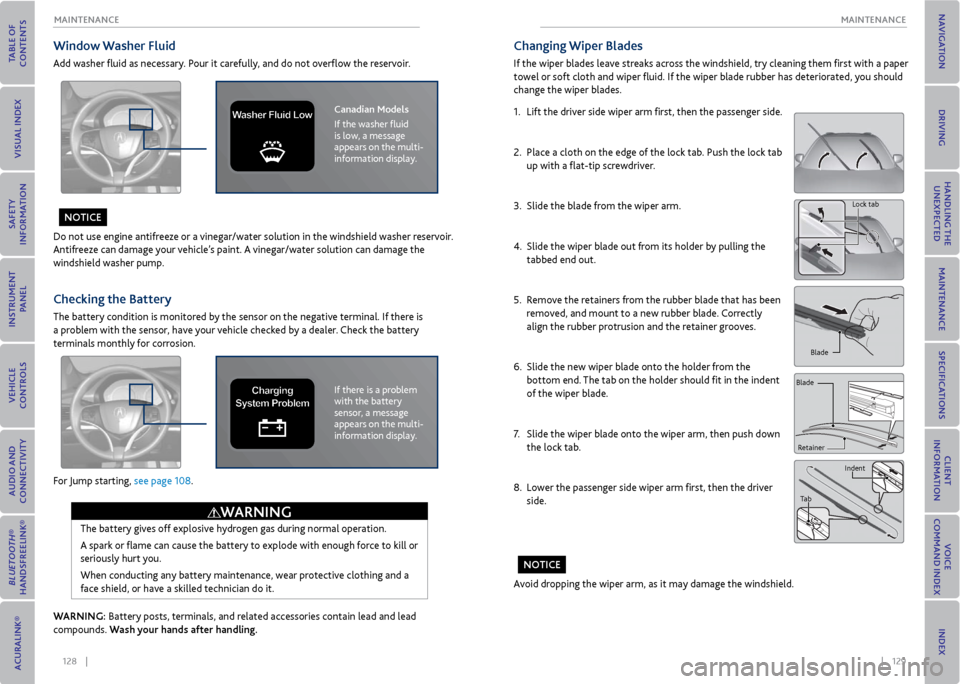
128 || 129
mAINTeNANCe
mAINTeNANCe
Window Washer Fluid
Add washer fluid as necessary. Pour it carefully, and do not overflow the reservoir.
Do not use engine antifreeze or a vinegar/water solution in the windshield washer reservoir.
Antifreeze can damage your vehicle’s paint. A vinegar/water solution can damage the
windshield washer pump.
For Jump starting, see page 108.
Checking the Battery
The battery condition is monitored by the sensor on the negative terminal. If there is
a problem with the sensor, have your vehicle checked by a dealer. Check the battery
terminals monthly for corrosion.
The battery gives off explosive hydrogen gas during normal operation.
A spark or flame can cause the battery to explode with enough force to kill or
seriously hurt you.
When conducting any battery maintenance, wear protective clothing and a
face shield, or have a skilled technician do it.
WArNING
Canadian models
If the washer fluid
is low, a message
appears on the multi-
information display.Washer Fluid Lo w
WArNING: Battery posts, terminals, and related accessories contain lead and lead
compounds. Wash your hands after handling.
If there is a problem
with the battery
sensor, a message
appears on the multi-
information display.Charging
System Problem
No TICe
Changing Wiper Blades
If the wiper blades leave streaks across the windshield, try cleaning them first with a paper
towel or soft cloth and wiper fluid. If the wiper blade rubber has deteriorated, you should
change the wiper blades.
1. Lift the driver side wiper arm first, then the passenger side.
2. Place a cloth on the edge of the lock tab. Push the lock tab
up with a flat-tip screwdriver.
3. Slide the blade from the wiper arm.
4. Slide the wiper blade out from its holder by pulling the
tabbed end out.
5. Remove the retainers from the rubber blade that has been
removed, and mount to a new rubber blade. Correctly
align the rubber protrusion and the retainer grooves.
6. Slide the new wiper blade onto the holder from the
bottom end. The tab on the holder should fit in the indent
of the wiper blade.
7. Slide the wiper blade onto the wiper arm, then push down
the lock tab.
8. Lower the passenger side wiper arm first, then the driver
side.
Lock tab
Blade
Retainer
Blade
Indent
Tab
Avoid dropping the wiper arm, as it may damage the windshield.
No TICe